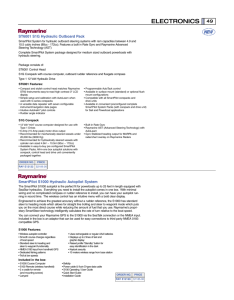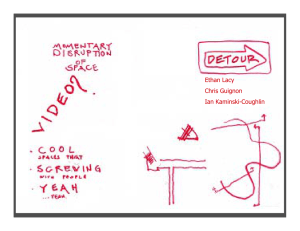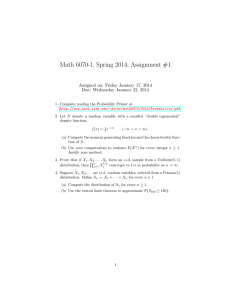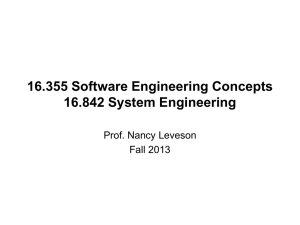Raymarine S100 Controller User Guide
advertisement
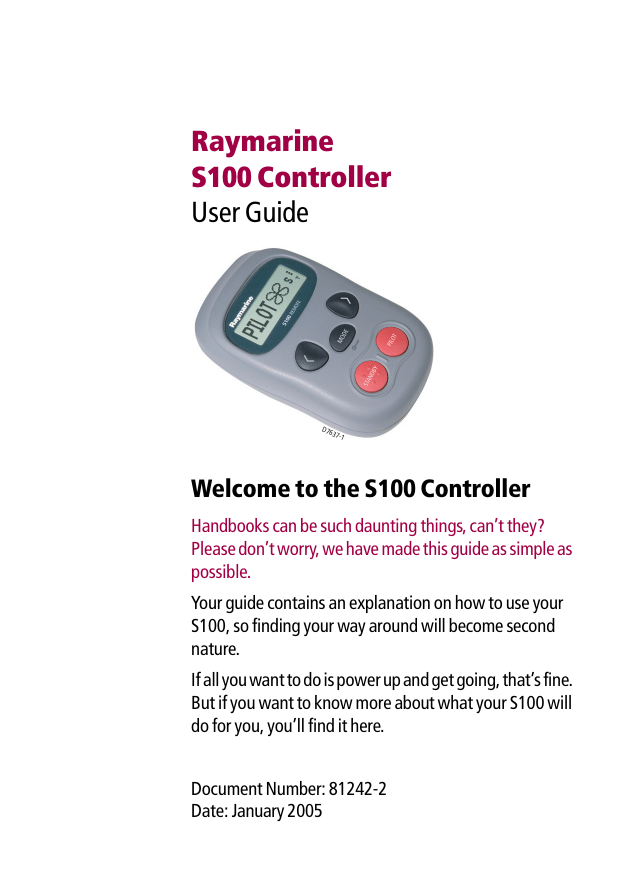
Raymarine S100 Controller User Guide D76 37-1 Welcome to the S100 Controller Handbooks can be such daunting things, can’t they? Please don’t worry, we have made this guide as simple as possible. Your guide contains an explanation on how to use your S100, so finding your way around will become second nature. If all you want to do is power up and get going, that’s fine. But if you want to know more about what your S100 will do for you, you’ll find it here. Document Number: 81242-2 Date: January 2005 Contents D7 69 4-1 S100 Controller 2 Raymarine S100 Controller 1 - Getting Started Changing the Controller batteries ........................................ 5 The S100 Autopilot Controller .............................................. 6 How do I power the system on? ............................................ 7 2 - Using your S100 How do I use the autopilot?.................................................. 9 How do I automatically steer straight? ............................... 10 How do I follow a route from my GPS? ............................... 11 How do I follow a circle pattern? ........................................ 12 How do I follow a zig-zag pattern? ..................................... 13 How do I follow a cloverleaf pattern? ................................. 14 How do I steer to a fixed wind angle? ................................. 15 How do I tack using the autopilot? ..................................... 16 How do I dodge an obstacle? .............................................. 17 3 - Setting up your S100 How do I change the pattern direction? .............................. 19 How do I change my boat type? .......................................... 20 4 - Alarms and Troubleshooting S100 Alarm messages ........................................................ 23 Fault finding ....................................................................... 25 General maintenance ......................................................... 26 Dealer Maintenance Procedures ......................................... 26 Product support .................................................................. 29 5 - Important Information Safety Notices ..................................................................... 31 Intended Use ...................................................................... 33 Declaration of Conformity .................................................. 34 EMC Guidelines .................................................................. 34 User Guide 3 D7639-1 Getting started . . . 4 Raymarine S100 Controller Changing the Controller batteries The S100 Controller is powered by 2 AAA batteries which are located in the back of the unit. Ensure that only good quality alkaline batteries are used. Do not use rechargeable batteries. A small cross-head screwdriver will be required to undo the battery cover screws. Remove the batteries from the unit if you do not intend using it for more than a month. Follow the battery manufacturers’s instructions for proper care and disposal of used batteries. User Guide D7641-1 5 The S100 Autopilot Controller NAVIGATE PORT Use in PILOT mode to power steer your boat. Press and hold for Smart Steer NAVIGATE STARBOARD Use in PILOT mode to power steer your boat. Press and hold for Smart Steer PILOT Use to activate the autopilot. MODE Press to select required pilot mode. D7642-1 STANDBY (POWER ON) When off, press to power on the S100 Use to return to manual control of your boat when in PILOT mode. Press and hold to access Pilot Setup 6 Raymarine S100 Controller How do I power the system on? POWER ON Ensure that you autopilot and basestation is powered on at the ships breaker. On the controller, press and hold the STANDBY button. The handset will beep, the display will read STANDBY and you’re ready to go. Power Saving Mode If you are in STANDBY mode (autopilot off), the handset will automatically turn off if no button has been pressed for 5 minutes. This will help to extend the battery life. Wireless signal strength Keylock D7667-1 Wireless signal strength (5 levels) is shown on the right hand side of the display. When using your S100, you can temporarily lock the autopilot keys to ensure that it is not accidentally operated. How do I activate the keylock? Press and hold the mode button until you see the key symbol and “LOCK” message. Note: You cannot activate keylock when the autopilot is in control of your boat. How do I turn off the keylock? Press mode followed by the PILOT button. A “KEYLOCK OFF” message will be displayed. User Guide 7 Using your D7695-1 S100 Controller 8 Raymarine S100 Controller How do I use the autopilot? Your autopilot can steer your boat according to one of its preset modes. The modes that are available are dependant on your boat and autopilot type. Each of these are explained on the following pages. Available modes POWER FISHING SAIL AUTO AUTO AUTO TRACK TRACK TRACK ZIGZAG* WIND CIRCLE* TACK CLOVER* Quick Tip User Guide You can change your boat type in the autopilot setup pages D7616-1 *S1000 autopilots only 9 How do I automatically steer straight? To continue on your current heading under autopilot control, use the AUTO mode. This will steer you in a straight line ahead until commanded otherwise. AUTO mode can be used in conjunction with SMARTSTEER to give you remote, power-steering control of your boat. 1 2 3 PILOT STANDBY Activates autopilot in AUTO mode Returns the boat to manual steering From any screen: 1. Steer your boat onto the desired heading. 2. Check that there are no obstructions. 3. Press the PILOT key to activate the autopilot. Quick Tip 10 AUTO mode is also available for selection via the MODE button D7617-1 AUTO Raymarine S100 Controller How do I follow a route from my GPS? Your autopilot can follow a route that you have previously set on your GPS or Chartplotter. Ensure that your GPS/Chartplotter is sending valid SeaTalk or NMEA 0183 data. 1 2 3 From any screen: MODE press repeatedly until you reach TRACK PILOT activates autopilot in TRACK mode 2. Press PILOT to activate TRACK mode. PILOT Press when asked to accept new heading. 3. If a valid route is received, the SmartController will tell you the direction in which it will turn the boat and the new heading it will steer to. Press PILOT to accept. PILOT Press when asked to accept new heading. TRACK User Guide Note: At each waypoint, confirmation of turn will be required. Press PILOT to accept. D7618-1 On arrival at each waypoint 1. Press MODE repeatedly until TRACK is displayed. 11 How do I follow a circle pattern? When you select CIRCLE mode, your current position is marked as the center of the circle pattern. Your autopilot will now gently steer your boat into the circle of the selected size. 1 2 3 MODE press repeatedly until you reach CIRCLE change pattern size (Sml, Med or Large) PILOT activates autopilot in CIRCLE mode From any screen: 1. Press MODE repeatedly until CIRCLE is displayed. 2. Use the PORT and STARBOARD keys to change the size (S, M or L) if required 3. Press the PILOT key to activate the autopilot Quick Tip 12 If your circles are gradually becoming larger, increase the response setting and restart the circle pattern. D7612-1 CIRCLE Raymarine S100 Controller How do I follow a zig-zag pattern? When you enter ZIGZAG mode, the autopilot will use your current position and heading as the center line of the zig-zag. The autopilot will now gently steer your boat into the pattern starting with a turn to starboard. 1 2 3 MODE press repeatedly until you reach ZIGZAG change pattern size (Sml, Med or Large) PILOT activates autopilot in ZIG ZAG mode From any screen: 1. Press MODE repeatedly until ZIGZAG is displayed. 2. Use the PORT and STARBOARD keys to change the size (S, M or L) if required 3. Press the PILOT key to activate the autopilot Quick Tip User Guide Fishing patterns are designed to work at speeds up to 15kts. Check your speed before starting. D7621-1 ZIGZAG 13 How do I follow a cloverleaf pattern? When you enter CLOVERLEAF mode, the autopilot will use your current position as the center point. The autopilot will then steer your boat through a series of starboard turns, repeatedly intersecting the start point. 1 2 3 MODE press repeatedly until you reach CLOVERLEAF change pattern size (Sml, Med or Large) PILOT activates autopilot in CLOVERLEAF mode From any screen: 1. Press MODE repeatedly until CLOVERLEAF is displayed. 2. Use the PORT and STARBOARD keys to change the size (S, M or L) if required 3. Press the PILOT key to activate the autopilot Quick Tip 14 You can change the pattern direction in PILOT SETUP (See section 3) D7622-1 CLOVERLEAF Raymarine S100 Controller How do I steer to a fixed wind angle? If your boat is equipped with a wind transducer, you can set the autopilot to steer at a fixed angle to the wind, WIND mode. You can adjust this angle to suit your needs. 1 2 3 MODE press repeatedly until you reach WIND PILOT activates autopilot in WIND mode and shows current wind angle. adjusts the desired wind angle From any screen: 1. Press MODE repeatedly until WIND is displayed. 2. Press PILOT to activate WIND mode. 3. The current wind angle will be displayed. Use the PORT and STARBOARD keys to change the angle as required. WIND Quick Tip User Guide For best results when heading upwind, sail slightly freer of the wind than if you were hand steering. D7623-1 WIND 15 How do I tack using the autopilot? When in WIND mode you can use the autopilot to execute a tack maneuver. The degree of turn is set by the autopilot (Refer to the handbook supplied with the autopilot for details on changing the tack angle) 1 2 3 MODE press repeatedly until you reach TACK select the desired tack direction PILOT press to start the TACK maneuver From any screen: 1. Press MODE repeatedly until TACK is displayed. 2. Use the PORT and STARBOARD keys to select the TACK direction. 3. Press PILOT to accept. TACK 16 D7624-1 WIND Raymarine S100 Controller How do I dodge an obstacle? Even when the autopilot is activated, you are are still able to override it. If, for example, you encounter an obstacle, or you just wish to change direction by a few degrees. This allows you to effectively power-steer your boat. 1 2 3 With the autopilot activated: or 1º course change press 10º course change or press and hold STANDBY returns the boat to manual steering With the autopilot activated: 1. A brief press of the PORT or STARBOARD key will make a 1º course change in that direction. Use this method for course changes up to 20º 2. A press and hold of the PORT or STARBOARD key will execute a 10º turn in that direction. 3. The autopilot will resume on the new heading. Dodge Quick Tip User Guide 10º When used with SMARTSTEER enabled autopilots, the press-and-hold command will activate SMARTSTEER D7625-1 1º 17 Setting up D7696-1 your S100 18 Raymarine S100 Controller How do I change the pattern direction? You can change the default autopilot pattern direction. 1 2 3 Pilot Setup STANDBY press and hold PATTERN DIRECTION MODE CLOCKWISE or ANTICLOCK or Normal mode STANDBY 1. Press and hold STANDBY for 2 seconds to enter PILOT SETUP mode. 2. Press mode until the display reads PATTERN DIRECTION 3. Press the PORT or STARBOARD key to toggle between CLOCKWISE and ANTICLOCK 4. Press STANDBY to leave Pilot setup and return to normal mode. Quick Tip User Guide The default direction is CLOCKWISE. The first turn in any pattern will always be to starboard D7649-1 CLOCKWISE PATTERN 19 How do I change my boat type? Your system can be set to suit the type of vessel to which it is fitted. This ensures that the user interface will offer you the most relevant features. 1 2 3 Pilot Setup STANDBY press and hold BOAT TYPE MODE POWER SAIL or FISHING or Normal mode STANDBY 1. Press and hold STANDBY for 2 seconds to enter PILOT SETUP mode. 2. Press mode until the display reads BOAT TYPE 3. Press the PORT or STARBOARD key to toggle between POWER, SAIL and FISHING 4. Press STANDBY to leave Pilot setup and return to normal mode. Quick Tip 20 S1000 Fishing patterns are only available in FISHING mode D7650-1 FISHING BOAT Raymarine S100 Controller User Guide 21 D7633-1 Alarms and Troubleshooting 22 Raymarine S100 Controller S100 Alarm messages When the S100 detects a fault or failure on the system, it will activate one of the alarm messages listed in the following table. Unless otherwise stated, you should respond to the alarm by pressing standby to clear the alarm and return to manual control, before you attempt to resolve the problem. In some situations, the S100 will raise more than one alarm. When you have dealt with the first alarm, it will display the next alarm. ALARM MESSAGE POSSIBLE CAUSE and SOLUTION CURRENT LIMIT Serious drive failure – the drive is taking too much current due to short-circuit or jamming. Check the drive unit and wiring. DRIVE STOPPED The autopilot is unable to turn the rudder (this occurs if the weather load on helm is too high. Check drive. INITIALISING This alarm occurs if you try to activate the pilot before it is ready. Your boat must be run at more than 3 knots for longer than 30 seconds before activating the pilot. LARGE XTE This alarm will sound when you are more than 0.3nm from your planned track. The alarm will also state if you are to PORT or STARBOARD of the track, LRN FAIL 1, 2 or 4 AutoLearn not completed successfully. Failure codes: 1 = AutoLearn has not been carried out 2 = AutoLearn failed, usually due to manual interruption 4 = AutoLearn failed, possibly due to drive failure Repeat the AutoLearn procedure. MOT POW SWAPPED Motor cables are connected to power terminals (and power cables are connected to motor terminals) at course computer. Turn off power and swap over connections. User Guide 23 ALARM MESSAGE POSSIBLE CAUSE and SOLUTION NO DATA The autopilot is in Track mode and: • the autopilot is not receiving SeaTalk navigation data, or • your GPS is receiving a low strength signal, this will clear when the signal improves Note: The autopilot stops adjusting the heading as soon as it loses data. NO GPS COG The S1000 autopilot is not receiving valid COG data from your GPS system. Check the connections and that your GPS unit is powered on and setup to transmit COG data. NO GPS FIX Your GPS is receiving a low strength signal, this will clear when the signal improves NO PILOT The controller is not receiving data from the autopilot. Check connections and that the autopilot. OFFCOURSE This alarm sounds if you have been off course from the locked heading for more than 20 seconds. It also states if you are to the PORT or STARBOARD of the intended heading. REGISTRATION INCOMPLETE The registration of your new handset cannot be completed as the system has detected other handsets in the vicinity. 1. Switch off all other remote handheld units. and repeat the registration process. 2. If this error persists, take your boat to open water (with no other vessel within 100 ft) and repeat the registration process. ROUTE COMPLETE This sounds on the completion of a track. Press PILOT to continue on the same heading or STANDBY for manual control. SHIPS BATTERY The ships battery voltage has dropped below acceptable limits, check the charge state of the battery. TOO SLOW Your speed has fallen below 3 knots. You must be travelling faster for the pilot to operate 24 Raymarine S100 Controller ALARM MESSAGE POSSIBLE CAUSE and SOLUTION TOO FAST TO FISH Fishing patterns will only operate at speeds below 15kts. Check your speed. WAYPOINT ADVANCE You have arrived at a waypoint on your route. The autopilot is now requesting permission to turn onto the next leg, press PILOT to accept. Fault finding All Raymarine products are designed to provide many years of trouble-free operation. We also put them through comprehensive testing and quality assurance procedures before shipping. If a fault occurs with your S100, use the fault finding tables in this section to help identify the problem and provide a solution. If you cannot resolve the problem yourself, refer to the product support information. SYMPTOM POSSIBLE CAUSE and SOLUTION Display is blank No power – press standby to power up the S100 or change the batteries. Autopilot not responding. Drive the boat for 30 seconds at above 2.5kts and retry. Check autopilot connections. Check GPS is switched on and connected. Boat turns slowly and takes a Rudder gain too low. Complete AutoLearn or long time to come onto course increase gain setting. Boat overshoots when turning Rudder gain too high. Complete AutoLearn or onto a new course decrease gain setting. Position information not received Navigator not transmitting the correct position data. The pilot will not auto advance No bearing to waypoint information received from to the next waypoint. the navigator. Instruments powered from SeaTalk will not power up User Guide Check connections Check fuses 25 General maintenance Routine checks The S100 controller does NOT contain user-serviceable parts. If you remove the main cover you will invalidate the warranty. It should be serviced only by authorized Raymarine service technician. As a result, user maintenance is limited to the following checks • • • make sure all cable connectors are firmly attached and free of corrosion examine for signs of wear or damage – replace any damaged cables replace batteries when necessary Cleaning the S100 Take care when cleaning the display. Avoid wiping the display screen with a dry cloth as this could scratch the screen coating. If necessary, only use a mild detergent. Never use chemical or abrasive materials to clean the computer or controller. If it is dirty, wipe it with a clean, damp cloth. Dealer Maintenance Procedures This section includes procedures that have a significant impact on autopilot operation and can affect your boat’s safety. You will not need to follow these procedures in normal operation. We therefore recommend that these are only performed by authorized service personnel. Accessing the dealer calibration area. From STANDBY mode, press and hold STANDBY for 2 seconds to enter PILOT SETUP. Then press and hold mode for 5 seconds until the dealer calibration screen is displayed. 26 Raymarine S100 Controller Subsequent presses of mode will cycle through the various calibration options. Hardware and Software version numbers Use this screen to display the version and serial numbers for the unit. Contrast Use the < and > keys to adjust the contrast to a satisfactory level. Self test Press PILOT to start the unit test sequence and then follow the on-screen instructions. This will test the display, buzzer and button functions. Diagnostics Press PILOT to display the status of the wireless link. Handset Registration Raymarine wireless systems demand that each wireless controller is “registered” to a basestation. This registration process is to prevent unauthorized control of your boat by another user nearby. Your S100 system is supplied with the handset pre-registered to the basestation. There may be instances where you want to move your controller to another boat and use it with another system. In this case, you will need to de-register from the current system and register with the new system. You can do this using the REGISTRATION function. User Guide 27 To Register a handset In the DEALER menu, at REGISTRATION, press PILOT. If the S100 is not registered, the display will read NOT REGISTERED. Press > to start the registration process, you can press < at any time to stop the search. HANDSET NOT REGISTERED REG > REGISTER START > SEARCHING < CANCEL When the basestation is found by the SmartController and registration is complete, the display will read REGISTERED D7657-1 For successful registration, ensure that all other handheld units on your boat are turned off. If you try to register a new handset with others active, you will see a REGISTRATION INCOMPLETE message. To de-register a handset. REGISTERED In the DEALER menu, at DE-REG > REGISTRATION, press PILOT If the D7674-1 S100 is already registered, then the display will read REGISTERED. Press > to continue, or STANDBY to cancel the operation. The S100 will attempt to communicate with the basesation and de-register. When complete, the display will read NOT REGISTERED. If the S100 cannot communicate with the basestation, a BASE NOT FOUND message will be displayed. It is still possible to de-register the S100 at this point by pressing >. To leave without de-registering, press STANDBY. Factory Reset This option will clear all settings from the S100. Press and hold the PILOT key for 2 seconds to activate the reset. Note: A reset does not alter the registration status of the S100 28 Raymarine S100 Controller Product support Raymarine products are supported by a worldwide network of distributors and Authorized Service Representatives. If you encounter any difficulties with this product, please contact either your national distributor, service representative, or the Raymarine Technical Services Call Center. Refer to the back cover or www.raymarine.com for contact details. Before you consider returning the autopilot, make sure that the power supply cable is sound and that all connections are tight and free from corrosion. If the connections are secure, refer to the Fault Finding section in this chapter. If you cannot trace or rectify the fault, contact your nearest Raymarine dealer or Service Center, specifying: The S100 controller serial number: • • the controller serial number is printed on its rear cover the controller software version number User Guide 29 D7659-1 Important Safety Information 30 Raymarine S100 Controller Safety Notices Product installation This equipment must be installed and operated in accordance with the instructions contained in this handbook. Failure to do so could result in poor product performance, personal injury and/or damage to your boat. As correct performance of the boat’s steering is critical for safety, we STRONGLY RECOMMEND that an Authorized Raymarine Service Representative fits this product. WARNING: Electrical Safety Make sure the power supply is switched off before you make any electrical connections. WARNING: Navigation aid Although we have designed this product to be accurate and reliable, many factors can affect its performance. As a result, it should only be used as an aid to navigation and should never replace common sense and navigational judgement. Always maintain a permanent watch so you can respond to situations as they develop. WARNING: Autopilot controller If the wireless controller is your only method of operating the autopilot, ensure that an in-line power switch is fitted to the autopilot power supply as detailed in the S1000 autopilot installation guide. Your S100 will add a new dimension to your boating enjoyment. However, it is the skipper’s responsibility to ensure the safety of the boat at all times by following these basic rules: • Ensure that someone is present at the helm AT ALL TIMES, to take manual control in an emergency. User Guide 31 • • • • • Make sure that all members of crew know how to disengage the autopilot. Regularly check for other boats and any obstacles to navigation – no matter how clear the sea may appear, a dangerous situation can develop rapidly. Maintain an accurate record of the boat’s position by using either a navigation aid or visual bearings. Maintain a continuous plot of your boat’s position on a current chart. Ensure that the locked autopilot heading will steer the boat clear of all obstacles. Make proper allowance for tidal set – the autopilot cannot. Even when your autopilot is locked onto the desired track using a navigation aid, always maintain a log and make regular positional plots. Navigation signals can produce significant errors under some circumstances and the autopilot will not be able to detect these errors. General Care and Safety Do not leave the controller in places where the temperature could exceed 60ºC (140ºF). Do not attempt to dismantle the S100 or any of its accessories. Switch off your S100 system at a refuelling point, even if you are not refuelling your own vessel. The operation of some medical electronic devices such as hearing aids and pacemakers, may be affected if a controller is used next to them. Observe the manufacturers recommendations for such devices. Radio frequency energy Your S100 and basestation are low- power radio transmitters and receivers. When it is turned on, they intermittently receive and transmit radio frequency (RF) energy (radio waves). 32 Raymarine S100 Controller Exposure to radio frequency energy The S100 and basestation are designed not to exceed the limits for exposure to RF energy set by national authorities and international health agencies These limits establish permitted levels of radio wave exposure for the general population. An example of a radio frequency exposure guideline and standard that these are designed to conform to is: BS EN 50371:2002 - Generic standard to demonstrate the compliance of low-power electronic and electrical apparatus with the basic restrictions related to human exposure to electromagnetic fields. FCC Information These devices comply with Part 15 of the FCC Rules. Operation is subject to the following two conditions: (1) these devices may not cause harmful interference and (2) these devices must accept interference received, including interference that may cause undesired operation. Changes or modifications to this equipment not expressly approved in writing by Raymarine could violate compliance with FCC rules and void the user's authority to operate the equipment. Disposal Disposal of this product, at the end of its useful life, should be in accordance with local regulations. Intended Use The S100 controller and basestation are intended for use on leisure vessels and small work boats User Guide 33 Declaration of Conformity Hereby Raymarine UK Ltd., declare that the S100 and basestation are in compliance with the essential requirements and other relevant provisions of the Directive 1999/5/EC The original Declaration of Conformity certificate may be viewed on the relevant product page at www.raymarine.com EMC Guidelines All Raymarine equipment and accessories are designed to the best industry standards for use in the recreational marine environment. Their design and manufacture conforms to the appropriate Electromagnetic Compatibility (EMC) standards, but correct installation is required to ensure that performance is not compromised. Connections to other equipment If your Raymarine equipment is to be connected to other equipment using a cable not supplied by Raymarine, a suppression ferrite MUST always be attached to the cable near to the Raymarine unit. Handbook Information To the best of our knowledge, the information in this handbook was correct when it went to press. However, Raymarine cannot accept liability for any inaccuracies or omissions it may contain. In addition, our policy of continuous product improvement may change specifications without notice. As a result, Raymarine cannot accept liability for any differences between the product and the handbook. SeaTalk® is a Registered Trademark of Raymarine All other trademarks used in this document are acknowledged. © Copyright Raymarine UK Limited 2004 34 Raymarine S100 Controller
